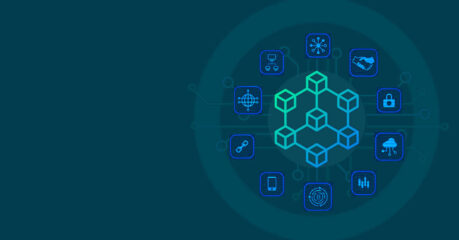How Much Does It Cost to Build and Implement Blockchain in 2023


How Much Does It Cost to Build and Implement Blockchain
- The Importance of Estimating the Blockchain Cost
- Types of Blockchain Projects
- What Are the Infrastructure and Tool Cost Elements for Building Blockchain Solutions on a Public Blockchain Network?
- Blockchain Development Cost
- What About “Permission” Blockchains?
- Hyperledger Fabric: The Easier Option to Build Enterprise Blockchain
- Estimating the Code Audit Effort
- How to Determine the Cost of Blockchain Implementation
- Conclusion: Estimation of the Blockchain Development Cost for Software Projects Is Key
The Importance of Estimating the Blockchain Cost
Blockchain’s popularity is on the rise, but is there any return on investment? Many potential applications exist for blockchain technology, demonstrating how lucrative the blockchain industry is for innovative new companies that tap into it and utilize it.
How much does it cost to develop a blockchain? Estimating cost is crucial in any project, especially when taking investors into consideration. In the context of blockchain technology, however, estimation takes on new significance.
How do you convince a corporation to allocate resources toward blockchain development and deployment when determining the return on investment (ROI) is challenging? You’ll need to do some thinking to determine the ROI and be sure to establish an estimate that includes a fair amount of assurance that it’s correct.
Knowing how much it costs to build a blockchain project is crucial.
Types of Blockchain Projects
Depending on your goals, blockchain projects might range from free to very expensive. At its most general level, blockchain initiatives can be divided into two categories:
- Developing blockchain-based decentralized applications (dApps)
- Constructing a blockchain network suitable for large-scale business use
Do you intend to create a decentralized system for conducting business? Tokenized cryptocurrencies will enable peer-to-peer (P2P) transactions between users. But maybe you’re the head of software development at a large company and you want to use blockchain to boost productivity. Alternatively, you may use blockchain technology to create a business-to-business (B2B) platform. As a result of legal and ethical considerations, such systems need to keep user information secret.


Expert Blockchain Development
We build decentralized applications and smart contracts for a variety of uses.
What Are the Infrastructure and Tool Cost Elements for Building Blockchain Solutions on a Public Blockchain Network?
You create a dApp when you design a blockchain project for a decentralized enterprise or game. Blockchain game development costs can range from $45,000 to $150,000 depending on the features included in the application.
As part of the dApp, a designer will create a cryptocurrency token. The front end of a dApp is likewise created by programmers. It’s important to remember that this is not a massive new infrastructure deployment. There is already a blockchain network in place when you utilize Ethereum, NEO, or EOS.
One such solution is to utilize the Lisk blockchain application platform. But even then, you’ll make use of what you already have set up. Important tools for this endeavor, such as web3.js, Truffle, etc., are freely available to the public as open source.
To launch your dApp on the platform, you will need to acquire the platform’s native coin. Buying Ether, for instance, is required for deploying blockchain on the Ethereum platform. When it comes to storing your cryptocurrency, services like the ETH-light wallet are available for no cost on the web.
When not in use, your cryptocurrency holdings should be safely stored. It’s inexpensive and only needs to be paid once.
The ecosystem of the main Ethereum development tools
To create dApps on Ethereum, it typically requires the following:
- Ganache: a simple and straightforward blockchain client
- Web3.js: a popular Ethereum API written in JavaScript
- Truffle: a tool that facilitates the management of Ethereum smart contracts, including their compilation, testing, and deployment
- MetaMask: a browser add-on that is useful as a popular Ethereum wallet
- The Solidity programming language: used by the Remix IDE, which allows developers to create smart contracts for Ethereum
- Ropsten: Ethereum’s test network; developers can use Ropsten to simulate the operation of smart contracts; imitation Ether can be used instead of the real thing
- In some cases, you’ll want to ensure that your dApp can be easily expanded.
You can benefit from Loom Network’s scalability options. LOOM tokens will be required for this transaction.
Note about Ethereum development tutorials
Ethereum development tutorials may be useful for programmers with less experience. Tutorials for creating Ethereum applications may be found on the official Ethereum website, put together by developer, consultant, and writer Narayan Prusty. Prusty has written a thorough book on blockchain development titled Building Blockchain Projects.
What if you develop applications on the Bitcoin network?
There is a wide variety of practical applications for Ethereum. Some may consider the Ethereum blockchain to be the most popular platform for blockchain development, but that’s not the case.
You may find many of Ethereum’s amenities on the Bitcoin network as well. Among these are the P2P network, the Proof-of-Work (PoW) consensus mechanism, the distributed ledger, and so on. Bitcoin’s open-source nature has attracted many programmers who are building new Bitcoin applications.
Similarly, special infrastructure is not required, just a team of Bitcoin programmers. In the United States, a skilled Bitcoin developer can make up to $172,000 annually.
Many tools and resources are available to Bitcoin programmers:
- Tutorials for Bitcoin programmers
- Bitcoin development network
What if you develop applications on the Ripple network?
Blockchain networks like Ethereum and Bitcoin don’t require authorization to operate. What do you do if you want to build an app for the private Ripple network?
Ripple is well known for its contributions to international money transfers. It goes beyond the capabilities of standard digital currency. The company provides a means to make instantaneous international payments without the use of middlemen.
Hiring programmers who have worked with the Ripple network is a necessity for a successful dApp. Even among the subset of blockchain-related abilities, it’s a rather specific platform. The RippleX open developer platform is a rich source of information for programmers.
Blockchain Development Cost
The options for blockchain networks when creating blockchain apps are extensive. The costs associated with creating dApps for different platforms might range widely. The cost of blockchain development (including Ethereum, Hyperledger Fabric, Ripple, and EOS) ranges from $6,000 to $400,000.
Blockchain app development costs can also be impacted by aspects such as machine learning, microservices, front-end design, and back-end development among others when working with many blockchains.
Estimates of design and development complexity are among the elements that can swiftly drive up upfront development expenses.
Creating an app for a mobile device or a website typically has lower development costs. It’s also worth noting that front-end and back-end developers are easier to find and recruit than app developers because there are fewer elements to develop.
To create dApps, Ethereum is a popular choice. Any developer with a concept for an open-source program that could benefit from smart contracts and a desire to work in a decentralized environment can utilize the same platform to make their vision a reality.
What About “Permission” Blockchains?
But what if you’re not using a public blockchain like Ethereum to create your dApp?
Due to data privacy, data storage, and scalability constraints, companies cannot use public blockchains when implementing a blockchain solution for efficiency gain within an enterprise organization or when constructing a consortia blockchain solution for trading reasons. There is a need to create a blockchain network where only authorized users can transact.
Building blockchain projects for enterprises from scratch
Is it possible to create your own private blockchain from the ground up? If you are considering this option, the following concerns must be addressed:
- Infrastructure
- Storage space
- Network speed
- P2P network
- Encryption
- Smart contracts
- Front-end
1. Arranging the IT infrastructure, storage, and network
We recommend working with reputable cloud Infrastructure-as-a-Service (IaaS) providers for your server, network, and data storage needs. Cloud computing models like IaaS take care of problems with the underlying hardware, networking, and software. This is useful for new businesses since it means they can put off making costly investments in infrastructure like data centers, software, etc.
When it comes to cloud services, AWS is among the most trustworthy options available. Another viable choice is the IBM Cloud IaaS. There is a rise in the number of IaaS suppliers, all of whom prominently list their costs and benefits online.
2. Building a P2P network from scratch
Making a P2P network is the next logical step. Create a P2P network and employ cutting-edge data encryption methods. Blockchain development manuals are an excellent resource for learning more. Taking this road requires the services of P2P networking engineers and cryptography experts
3. Building the consensus algorithm
The next action is to construct the consensus algorithm. The Go programming language (also known as Golang) has documentation that can help you put this together. “Code your own blockchain mining algorithm in Go!” provides details on how to implement the Proof-of-Work (PoW) algorithm.
A Proof-of-Stake (PoS) algorithm can be constructed as an alternative. There are benefits and drawbacks to both PoW and PoS. The PoS system is the safest option because of its decentralized nature. Even so, it uses a lot of power.
While PoS uses less energy than other methods, it is not without its downsides. For additional information, check out our article “Proof of Work vs. Proof of Stake Contrast.”
Integrate a file-sharing solution
Perhaps you’ll need to enable file-sharing in your blockchain, depending on its intended function. The Interplanetary File System (IPFS), or a similar P2P file-sharing protocol, is what you’ll need here. Seek out blockchain engineers who have worked with IPFS before. The cost of creating a blockchain may rise as a result of the long hiring process required.
The cost of developers for building blockchain projects from scratch
This method is rather complicated. You’ll need to recruit P2P network experts, encryption experts, blockchain engineers, and Golang programmers. According to Salary.com, a network engineer’s average annual income in the United States is $72,107.
Engineers proficient in cryptography should be employed as security guards. They average $105,000 per year in salary in the United States. In addition, you must hire penetration testers. The average annual salary in the United States is said to be $86,000.
Hyperledger Fabric: The Easier Option to Build Enterprise Blockchain
The Hyperledger Fabric blockchain framework is widely used in the business world.
This option comes to us courtesy of the Hyperledger Consortium. The Hyperledger Consortium is a group effort spearheaded by the Linux Foundation. Enterprise blockchain platforms, tools, techniques, processes, and solutions have been developed by a consortium of industry leaders.
The consortium has developed multiple projects, such as Hyperledger Indy and Hyperledger Sawtooth, but Fabric is seen as the most innovative by experts in the field.
There are two main categories of expense involved in establishing a blockchain utilizing Hyperledger Fabric: the infrastructure cost and the development cost. As the market leaders in cloud computing already provide Hyperledger Fabric infrastructure, this method is simpler.
Infrastructure costs for using Hyperledger Fabric
Hyperledger Fabric reduces the need for custom programming by facilitating reuse. In other words, you can avoid the need to create things like an encryption program and a consensus algorithm.
You’ll need to look at a Blockchain-as-a-Service (BaaS) product from a reliable cloud service provider. In the cloud, the hardware and software required to run the platform are already taken care of for you.
IBM blockchain platform
IBM’s blockchain platform is available thanks to the company’s cloud computing and blockchain technologies. The Hyperledger Fabric platform is included.
Blockchain on AWS
The BaaS offered by AWS is feature-rich. Hyperledger Fabric can be utilized in this situation.
SAP blockchain services
SAP’s blockchain services are now accessible within the SAP business technology platform. The company offers Hyperledger Fabric in addition to other blockchain services.
Azure blockchain
Microsoft’s blockchain platform Azure is available for use. Hyperledger Fabric is part of Azure Blockchain.
The cost of Hyperledger Fabric developers
Even among the family of blockchain options, Hyperledger Fabric is a premium skill. Hyperledger Fabric programmers command above-average salaries.
Estimating the Code Audit Effort
Up to this point, we have only covered the labor expenses associated with building infrastructure and advancing a project. However, the expense of a code audit is an additional consideration for blockchain initiatives.
The consequences of coding-flawed smart contracts could be severe. You must use bug-free smart contracts in your system. Examining them thoroughly is a given. Such audits can be costly and require the expertise of only the most seasoned blockchain experts. Making this an ongoing project requires a financial commitment from you.
Auditing the code of a blockchain system involves the following steps:
- Reviewing the project documentation
- Preliminary code review
- Static code analysis
- Auditing smart contracts to find vulnerabilities like reentrancy, shadowing of variables, vulnerable storage pointers, overflows, underflows, etc.
- Functionality analysts
- Reporting and closure of defects
How to Determine the Cost of Blockchain Implementation
App features, complexity, blockchain type, blockchain platform, and additional technology stacks all affect the final price tag for developing a blockchain app.
Before looking at the costs of deploying blockchain, think about the following:
- Do you want to make something completely new using blockchain technology, or will blockchain integration suffice?
- In what way will your product utilize blockchain hosting? Blockchain, private, or public?
- Does your program require the handling of monetary transactions?
- Are you using cloud services for your product that aren’t part of the blockchain network?
- How would you like to interact with the product? Accessible via a web browser, mobile app, admin panel, or all three!
Is a Proof of Concept necessary? - Just how many people do you expect to use your service?
Cost of blockchain implementation: process
How much does blockchain cost to implement? The total cost includes money spent on many different aspects or stages of the project:
- Wireframes, high-fidelity designs with a prototype, and low-fidelity designs with app flow are all part of the design process, as are the system blueprint and user interface (UI)/user experience (UX) design
- Development: programming and verifying
- Cloud platform deployment, delivery, and development and operations (DevOps)
- Converting an existing system to function on a blockchain network (migration)
- Ensuring that the software is compatible with all operating system versions and receiving regular updates
- Smart contract updates and new functionality
- Hosting, data storage, alert system, and coordination platform
Cost of blockchain implementation: the complexity of a blockchain app
There is a direct correlation between the scope of your project and the final cost of implementing blockchain technology.
A blockchain project’s complexity is determined by a variety of things. Knowing the app’s intended use case, the issues its target audience has, the need for blockchain-based solutions, the nature of the transformation your app promises to bring about, and the current state of the market can help you determine the best blockchain app to meet your needs.
Cost of blockchain implementation: development resources
The expense of assembling a development team is a major factor in the expected total cost. Although software engineers’ salaries account for the bulk of costs, other elements such as perks, vacation time, incentive pay, payroll taxes, and holidays should not be overlooked. There are a variety of options for developing a blockchain app, each with its own set of pros and cons, blockchain implementation costs, and time commitments.
A few methods for creating an app are as follows:
- Developing blockchain-based software internally
- Contracting with an independent developer to create a blockchain-based app
- Outsourcing the development of a blockchain application
In-house vs freelancer vs agency: Which should you choose?
In-house team
Maintaining in-house blockchain developers appears to be only a financial challenge. However, deeper thought reveals many considerations. In an emergency, your devoted team will prioritize you. You will handle blockchain app development and team expenses including holidays, rewards, workspace, and more.
Freelancers
Though using freelancers for blockchain app development may be cheaper, 80% of organizations encounter challenges including availability, response time, and quality.
If your project is tiny, you can hire a freelancer. Just keep in mind that project scope increases risk.
Agency
Agencies offer cheaper blockchain app development than in-house teams. They sign a contract with deliverables and deadlines before starting your project. They can help you concentrate on your core business.
Conclusion: Estimation of the Blockchain Development Cost for Software Projects Is Key
In 2023, investing in blockchain app development will prove profitable. Apps for online trading, investing, and currency exchange have already used blockchain features and are providing the most trustworthy services. Blockchain apps are superior because they provide rapid and secure money transactions, account access at any time, transparency, and customization.
Written by Vitaliy Basiuk
COO & Co-founder at EvaCodes | Blockchain Enthusiast | Providing software development solutions in the blockchain industry





